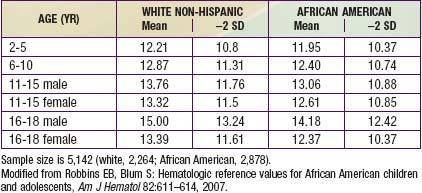Chapter 441 The Anemias
Anemia is defined as a reduction of the hemoglobin concentration or red blood cell (RBC) volume below the range of values occurring in healthy persons. “Normal” hemoglobin and hematocrit (packed red cell volume) vary substantially with age and sex (Table 441-1). There are also racial differences, with significantly lower hemoglobin levels in African-American children than in white non-Hispanic children of comparable age (Table 441-2).
Table 441-1 NORMAL MEAN AND LOWER LIMITS OF NORMAL FOR HEMOGLOBIN, HEMATOCRIT, AND MEAN CORPUSCULAR VOLUME

Table 441-2 NHANES III HEMOGLOBIN VALUES FOR NON-HISPANIC WHITES AND AFRICAN AMERICANS AGED 2-18 YEARS

Physiologic adjustments to anemia include increased cardiac output, augmented oxygen extraction (increased arteriovenous oxygen difference), and a shunting of blood flow toward vital organs and tissues. In addition, the concentration of 2,3-diphosphoglycerate (2,3-DPG) increases within the RBC. The resultant “shift to the right” of the oxygen dissociation curve reduces the affinity of hemoglobin for oxygen and results in more complete transfer of oxygen to the tissues. (The same shift in the oxygen dissociation curve can also occur at high altitude.) Higher levels of erythropoietin (EPO) and consequent increased red cell production by the bone marrow further assist the body to adapt.
History and Physical Examination
As with any medical condition, a detailed history and thorough physical exam are essential when evaluating an anemic child. Important historical facts should include age, sex, race and ethnicity, diet, medications, chronic diseases, infections, travel, and exposures. A family history of anemia and/or associated difficulties such as splenomegaly, jaundice, or early-age onset of gallstones is also of consequence. There often are few physical symptoms or signs that result solely from a low hemoglobin, particularly when the anemia develops slowly. Clinical findings generally do not become apparent until the hemoglobin level falls to <7-8 g/dL. Clinical features can include pallor, sleepiness, irritability, and decreased exercise tolerance. Pallor can involve the tongue, nail beds, palms, or palmar creases. A flow murmur is often present. Ultimately, weakness, tachypnea, shortness of breath on exertion, tachycardia, cardiac dilatation, and high-output heart failure will result from increasingly severe anemia, regardless of its cause. Unusual physical findings linked to particular underlying disease etiologies are discussed in detail in sections describing the associated disorders.
Laboratory Studies
Initial laboratory testing should include hemoglobin, hematocrit, and red cell indices as well as a white blood cell count and differential, platelet count, reticulocyte count, and examination of the peripheral blood smear. The need for additional laboratory studies is dictated by the history, the physical, and the results of this initial testing.
Differential Diagnosis
Anemia is not a specific entity but rather can result from any of number of underlying pathologic processes. In order to narrow the diagnostic possibilities, anemias may be classified on the basis of their morphology and/or physiology (Fig. 441-1).
Stay updated, free articles. Join our Telegram channel

Full access? Get Clinical Tree


